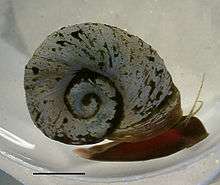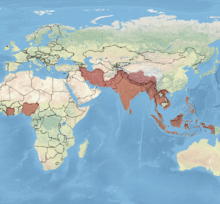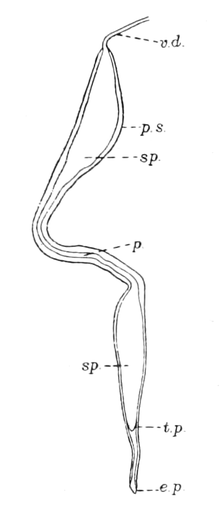Indoplanorbis
Indoplanorbis is a genus of air-breathing freshwater snail. Its only member species is Indoplanorbis exustus, an aquatic pulmonate gastropod mollusk in the family Planorbidae, the ram's horn snails. The species is widely distributed across the tropics. It serves as an important intermediate host for several trematode parasites.[7] The invasive nature and ecological tolerance of Indoplanorbis exustus add to its importance in veterinary and medical science.[7]
| Indoplanorbis | |
|---|---|
 | |
| Scientific classification | |
| Kingdom: | |
| Phylum: | |
| Class: | |
| (unranked): | |
| Superfamily: | |
| Family: | |
| Subfamily: | Bulininae |
| Tribe: | Bulinini |
| Genus: | Indoplanorbis |
| Species: | I. exustus |
| Binomial name | |
| Indoplanorbis exustus | |
| Synonyms[5][6] | |
|
Planorbis exustus Deshayes, 1834 | |
Taxonomy
Indoplanorbis exustus is the only known species in the genus Indoplanorbis. In spite of its long history and wide geographical range, it is thought that Indoplanorbis includes only a single species.[7] However phylogeography research by Liu et al. (2010)[7] revealed the phylogenetic depth of divergences between the Indian clades and Southeast Asian clades, together with habitat and parasitological differences suggest that Indoplanorbis exustus may comprise more than one species.[7]
The most phylogenetically related genus to Indoplanorbis is genus Bulinus.[8]

Distribution
The freshwater snail Indoplanorbis exustus is found across Iran,[9] Nepal,[9] India, Sri Lanka,[10] Southeast Asia (for example Thailand),[7] central Asia (Afghanistan),[11] Arabia and Africa.[7]
The type locality of Indoplanorbis exustus is marshes on the coast of Malabar in southwestern India.[5]
Indoplanorbis exustus is a common snail across Southeast Asia and the Indian sub-continent.[7] The snail is also found in the Middle East (Oman[12] and Socotra[5]) and Nigeria and the Ivory Coast;[7] these findings were attributed by Brandt (1974)[13] to recent introductions by human activities (Brandt's view has been frequently cited in the literature on Indoplanorbis).[5][7][12][14] In contrast to Asia, the well documented appearance of the snail in Africa (e.g., Nigeria[8] and Ivory Coast[15]) and more recently (2002) in the Lesser Antilles,[14] is almost certainly the result of introductions through human activities over the last 50–100 years.[7]
This species is already established in the USA, and is considered to represent a potentially serious threat as a pest, an invasive species which could negatively affect agriculture, natural ecosystems, human health or commerce. Therefore it has been suggested that this species be given top national quarantine significance in the USA.[16]
Biogeography
Meier-Brook (1984)[17] adopted an African (Gondwanan) origin for Indoplanorbis with rafting to Asia since the Cretaceous on the northward migrating Indian craton; this author also considered a Europe to Southwest Asia tract or an Africa to South India dispersal.[7] Morgan et al. (2002)[18] attributed the occurrence of Indoplanorbis in India to colonization (from Africa) via the Middle East land connection.[7] Clearly the two different dispersal mechanisms imply very different chronologies; the Gondwanan vicariance hypothesis implies that proto-Indoplanorbis has been present in India since the late Eocene (35 Ma; India: Asia collision), whereas dispersal via the Sinai-Levant suggests a Plio-Pleistocene arrival.[7] The results by Liu et al. (2010) indicated a radiation beginning in the late Miocene with a divergence of an ancestral bulinine lineage into Assam and peninsular India clades.[7] A Southeast Asian clade diverged from the peninsular India clade late-Pliocene; this clade then radiated at a much more rapid pace to colonize all of the sampled range of Indoplanorbis in the mid-Pleistocene.[7]
Description

v.d. = vas deferens,
p.s. = penis heath,
sp. = sperm duct,
p. = penis,
e.p. = external opening.
The shell of this species, like all planorbids is sinistral in coiling, but is carried upside down and thus appears to be dextral. The shell of Indoplanorbis exustus is discoid with rapidly increasing whorls.[5] Each whorl is higher than it is wide.[5] The width of the shell is 5[8]-25 mm.[5] The height of the shell is 4.5[8]-13 mm.[5]
Five views of a shell. |
Planorbella duryi and Biomphalaria pfeifferi have similar shells.[8]
Because of its wide distribution, various aspects of Indoplanorbis exustus have been studied, such as its calcium regulation[19] and its hemocytes.[20]
Ecology
In captivity Indoplanorbis exustus can be reared on lettuce[21] and spinach.[22] Its diet is sometimes supplemented with sheep's liver[22] and it can be given rat food to prepare for breeding.[22]
Habitat
The snail is found in small ponds, pools, and less commonly in rice paddy fields.[7] The snail may also occur in semi-permanent pools formed in flooded areas of fields, where it can survive the dry season buried in mud.[7] The desiccation tolerance of adult snails is high, while the resistance of juvenile snails is very low.[23] Consequently, dispersal may occur in clumps of mud adhered to the bodies of cattle or across water in vegetation mats. It is possible it could be transported by birds.[7]
Life cycle
Indoplanorbis exustus is a hermaphroditic invasive snail species with high fecundity.[7] Within one year of introduction the snail is able to colonize habitats with well established populations of other pulmonate and prosobranch snails.[7] The snail requires a water temperature in excess of 15 °C for maturation.[7] At the optimum temperature of 30 °C each snail can lay up to 800 eggs.[7] There is from 2 to 43 eggs in one cluster with an average 20 eggs in one cluster.[24] The capacity for self-fertilization and high fecundity probably underlies the invasive potential of the species.[7] The average life span of Indoplanorbis exustus is 4 months[24] and during this time it lays about 60 egg clusters.[24]
Predators
Eggs of Indoplanorbis exustus were experimentally predated and destroyed by Pomacea bridgesii.[24] Raut & Aditya (2002) hypothetized that Pomacea bridgesii could be a potential biocontrol agent for Indoplanorbis exustus.[24]
Parasites
Indoplanorbis is of economic importance in that it is responsible for the transmission of several species of the genus Schistosoma which infect cattle and cause reduced livestock productivity.[7] The snail is also of medical importance as a source of cercarial dermatitis among rural workers, particularly in India.[7]
Indoplanorbis exustus is best known as the intermediate host responsible for the transmission of Schistosoma nasale and S. spindale, as well as other trematodes such as Echinostoma spp. and some spirorchids.[7] A third species of Schistosoma, S. indicum (Montgomery, 1906), is also transmitted by I. exustus.[7] Other snails have been implicated in transmission of these three Schistosoma species (such as Lymnaea luteola, a host for S. indicum and S. nasale, and L. acuminata, a host for S. nasale and S. spindale), I. exustus is the most important host for S. nasale and S. spindale, as well as for S. indicum in certain regions. I. exustus may be the sole natural intermediate host for these three Schistosoma species on the Indian sub-continent.[7]
Indoplanorbis exustus is also an intermediate host for:
- Artyfechinostomum malayanum - as the first intermediate host[25]
- Hypoderaeum conoideum - as the first intermediate host[25]
- Fasciola gigantica[1]
- Paramphistomum mehrai[1]
- Paramphistomum explanatum[1]
- Gastrodiscus secundus[1]
- Petagifer srivastavi[1]
- Plasmiorchis orientalis[1]
- Pseudodiscus collinsi[1]
- Gastrothylax crumenifer[1]
- Enterohaemotrema paleorticum[1]
- Cotylophoron cotylophorum[1]
- Cotylophoron indica[1]
- Cotylophoron bhaleraoi[1]
- Cotylophoron mathurapurensis[1]
Indoplanorbis exustus has been implicated in outbreaks of cercarial dermatitis in human populations in India, Laos, Malaysia and Thailand.[7] Cercarial dermatitis results from the cutaneous allergic reaction in people exposed to larval schistosomes (cercariae) shed by infected snails into freshwater bodies such as lakes, ponds, and paddy fields.[7] The cercariae cause pruritus (itching) and papular eruptions, with often severe secondary infections, as they attempt to infect a non-permissive definitive host and die in the skin.[7]
Toxicology
Aqueous extract of a common medicinal plant of India Euphorbia tithymaloides (Euphorbiaceae) has molluscicidal activity against Indoplanorbis exustus.[26]
Ethanol extract of Solanum xanthocarpum has molluscicidal activity against Indoplanorbis exustus LC50 = 198.00 mg/l and LC90 = 236.80 mg/l.[27]
The latex of Euphorbia milii has molluscicidal activity against Indoplanorbis exustus that depends on its hybrid of the plant.[28]
The molluscicidal activity of latex of Cascabela thevetia, Alstonia scholaris and Euphorbia pulcherrima against Indoplanorbis exustus was examined by Singh & Sunil (2005).[29]
Human use
It is a part of ornamental pet trade for freshwater aquaria.[30]
References
This article incorporates CC-BY-2.0 text from the reference.[7]
- Budha, P.B., et al. 2012. Indoplanorbis exustus. In: IUCN 2013. IUCN Red List of Threatened Species. Version 2013.1. Downloaded on 04 July 2013.
- Annandale, N. and B. Prashad. (1921). caption Aquatic Pulmonata: 565-592. Indoplanorbis is on pages 578-582. In: Annandale N., Prashad B. & Amin-ud-Din (1921). "The Aquatic and Amphibious Molluscs of Manipur". Records of the Indian Museum 22(4): 528-632.
- Prashad, B. & N. Annandale. (1921). "Report on a collection of Sumatran Molluscs from Fresh and Brackish water". Records of the Indian Museum 22(4): 461-508. Indoplanorbis is on pages 472-473.
- Deshayes G. P. (1834). in: Bélanger C. Voyage aux Indes-Orientales, Zool. 3: 417. plate 1, figures 11-13.
- Brown D. S. (1994). Freshwater snails of Africa and their medical importance. London: Taylor & Francis. 207-208.
- Preston, H. B. (1915). Mollusca. Freshwater Gastropoda & Pelecypoda. The Fauna of British India, Including Ceylon and Burma. Taylor & Francis, London, 244 pp., 29 figs. 115-116.
- Liu, L.; Mondal, M. M.; Idris, M. A.; Lokman, H. S.; Rajapakse, P. V. J.; Satrija, F.; Diaz, J. L.; Upatham, E. S.; Attwood, S. W. (2010). "The phylogeography of Indoplanorbis exustus (Gastropoda: Planorbidae) in Asia". Parasites & Vectors. 3: 57. doi:10.1186/1756-3305-3-57. PMC 2914737. PMID 20602771..
- Kristensen, T. K.; Ogunnowof, O. (1987). "Indoplanorbis exustus (Deshayes, 1834), a freshwater snail new for Africa, found in Nigeria (Pulmonata: Planorbidae)". Journal of Molluscan Studies. 53 (2): 245. doi:10.1093/mollus/53.2.245., abstract.
- Glöer, P.; Pešić, V. (2012). "The freshwater snails (Gastropoda) of Iran, with descriptions of two new genera and eight new species". ZooKeys (219): 11–61. doi:10.3897/zookeys.219.3406. PMC 3433696. PMID 22977349.
- Brant, S. V.; Morgan, J. A. T.; Mkoji, G. M.; Snyder, S. D.; Rajapakse, R. P. V. J.; Loker, E. S. (2006). "An Approach to Revealing Blood Fluke Life Cycles, Taxonomy, and Diversity: Provision of Key Reference Data Including Dna Sequence from Single Life Cycle Stages". Journal of Parasitology. 92 (1): 77–88. doi:10.1645/GE-3515.1. PMC 2519025. PMID 16629320.
-

- Brown, D. S.; Gallagher, M. D. (1985). "Freshwater snails of Oman, South Eastern Arabia". Hydrobiologia. 127 (2): 125. doi:10.1007/BF00004192.
- Brandt, R. A. (1974). "The non-marine mollusca of Thailand". Archiv für Molluskenkunde. 105: 1–423.
- Pointier, J. P.; Pointier, J. P.; David, P.; Jarne, P. (2005). "Biological invasions: The case of planorbid snails". Journal of Helminthology. 79 (3): 249–256. doi:10.1079/JOH2005292. PMID 16153319..
- Mouchet, F.; Rey, J. L.; Cunin, P. (1987). "Découverte dIndoplanorbis exustus (Planorbidae, Bulininae) à Yamossoukro, Côte d'Ivoire". Bull Soc Pathol Exot. 80: 811–812.
- Cowie, R. H.; Dillon, R. T.; Robinson, D. G.; Smith, J. W. (2009). "Alien Non-Marine Snails and Slugs of Priority Quarantine Importance in the United States: A Preliminary Risk Assessment". American Malacological Bulletin. 27 (1–2): 113–132. doi:10.4003/006.027.0210. PDF Archived 2016-06-16 at the Wayback Machine.
- Meier-Brook, C (1984). "A preliminary biogeography of freshwater pulmonate gastropods". World-wide Snails. 1: 23–27.
- Morgan, J.; Dejong, R. J.; Jung, Y.; Khallaayoune, K.; Kock, S.; Mkoji, G. M.; Loker, E. S. (2002). "A phylogeny of planorbid snails, with implications for the evolution of Schistosoma parasites". Molecular Phylogenetics and Evolution. 25 (3): 477–488. doi:10.1016/S1055-7903(02)00280-4. PMID 12450752..
- Vaidya, D. P.; Nagabhushanam, R. (1980). "Calcium regulation in the freshwater snail indoplanorbis exustus during shell repair". Hydrobiologia. 69 (1–2): 29–32. doi:10.1007/BF00016532.
- Mahilini, H. M.; Rajendran, A. (2008). "Categorization of hemocytes of three gastropod species Trachea vittata (Muller), Pila globosa (Swainson) and Indoplanorbis exustus (Dehays)". Journal of Invertebrate Pathology. 97 (1): 20–26. doi:10.1016/j.jip.2007.07.007. PMID 17765918..
- Haas, W.; Granzer, M.; Brockelman, C. R. (1990). "Finding and recognition of the bovine host by the cercariae of Schistosoma spindale". Parasitology Research. 76 (4): 343–350. doi:10.1007/bf00928190. PMID 2336448.
- Parashar, B. D.; Kumar, A.; Rao, K. M. (1986). "Role of Food in Mass Cultivation of the Freshwater Snail Indoplanorbis Exustus, Vector of Animal Schistosomiasis". Journal of Molluscan Studies. 52 (2): 120. doi:10.1093/mollus/52.2.120., abstract.
- Parashar, B. D.; Rao, K. M. (1982). "Effect of desiccation on freshwater snail, Indoplanorbis exustus, intermediate host of schistosomiasis". Japanese Journal of Medical Science & Biology. 35 (5–6): 243–247. doi:10.7883/yoken1952.35.243. PMID 7161940.
- Raut, S. K.; Aditya, G. (2002). "Destruction of Indoplanorbis exustus (Planorbidae) eggs by Pomacea bridgesi (Ampullariidae)". Molluscan Research. 22 (1): 87–90. doi:10.1071/MR02002.
- Chai, J. Y.; Shin, E. H.; Lee, S. H.; Rim, H. J. (2009). "Foodborne Intestinal Flukes in Southeast Asia". The Korean Journal of Parasitology. 47 (Supplement): S69–102. doi:10.3347/kjp.2009.47.S.S69. PMC 2769220. PMID 19885337.
- Tiwari, S.; Singh, S. K.; Singh, A. (2005). "THE CONTRIBUTION OF THE ANTICHOLINESTERASE ACTIVITY OF Pedialanthus tithymaloide TO ITS MOLLUSCICIDAL ACTIVITY". African Journal of Traditional, Complementary and Alternative Medicines. 2 (3): 326–336. doi:10.4314/ajtcam.v2i3.31131. Archived from the original on 2016-10-11. Retrieved 2010-07-25.
- Changbunjong, T.; Wongwit, W.; Leemingsawat, S.; Tongtokit, Y.; Deesin, V. (2010). "Effect of crude extract of Solanum xanthocarpum against snails and mosquito larvae". The Southeast Asian Journal of Tropical Medicine and Public Health. 41 (2): 320–325. PMID 20578514.
- Sermsart, B.; Sripochang, S.; Suvajeejarun, T.; Kiatfuengfoo, R. (2005). "The molluscicidal activities of some Euphorbia milii hybrids against the snail Indoplanorbis exustus". The Southeast Asian Journal of Tropical Medicine and Public Health. 36 Suppl 4: 192–195. PMID 16438208.. PDF.
- Singh, A.; Singh, S. K. (2005). "Molluscicidal evaluation of three common plants from India". Fitoterapia. 76 (7–8): 747–751. doi:10.1016/j.fitote.2005.08.002. PMID 16253436..
- Ng, T. H.; Tan, S. K.; Wong, W. H.; Meier, R.; Chan, S. Y.; Tan, H. H.; Yeo, D. C. (2016). "Molluscs for sale: assessment of freshwater gastropods and bivalves in the ornamental pet trade". PLoS ONE. 11 (8): e0161130. Bibcode:2016PLoSO..1161130N. doi:10.1371/journal.pone.0161130. PMC 4985174. PMID 27525660.
External links
| Wikimedia Commons has media related to Indoplanorbis. |
- Baker F. C. (1945). The molluscan family Planorbidae. The University of Illinois Press, Urbana. 196-201.
- Raut S. K. (1986). "Disease transmitting snails. II. Population studies of Indoplanorbis exustus Deshayes." First year PRS Thesis in Science, University of Calcutta.
- Raut, S. K.; Rahman, M. S.; Samanta, S. K. (1992). "Influence of temperature on survival, growth and fecundity of the freshwater snail Indoplanorbis exustus (Deshayes)". Memórias do Instituto Oswaldo Cruz. 87 (1): 15–19. doi:10.1590/s0074-02761992000100003. PMID 1308545.
- Yapi, Y.; n'Goran, K. E.; Salia, D.; Cunin, P.; Bellec, C. (1994). "Population dynamics of Indoplanorbis exustus (Deshayes, 1834) (Gastropoda: Planorbidae), an exotic freshwater snail recently discovered at Yamoussoukro (Ivory Coast)". Journal of Molluscan Studies. 60: 83–87. doi:10.1093/mollus/60.1.83..
- Devkota, R.; Brant, S. V.; Loker, E. S. (2015). "The Schistosoma indicum species group in Nepal: presence of a new lineage of schistosome and use of the Indoplanorbis exustus species complex of snail hosts". International Journal for Parasitology. 45 (13): 857–870. doi:10.1016/j.ijpara.2015.07.008. PMC 4651714. PMID 26385438.
